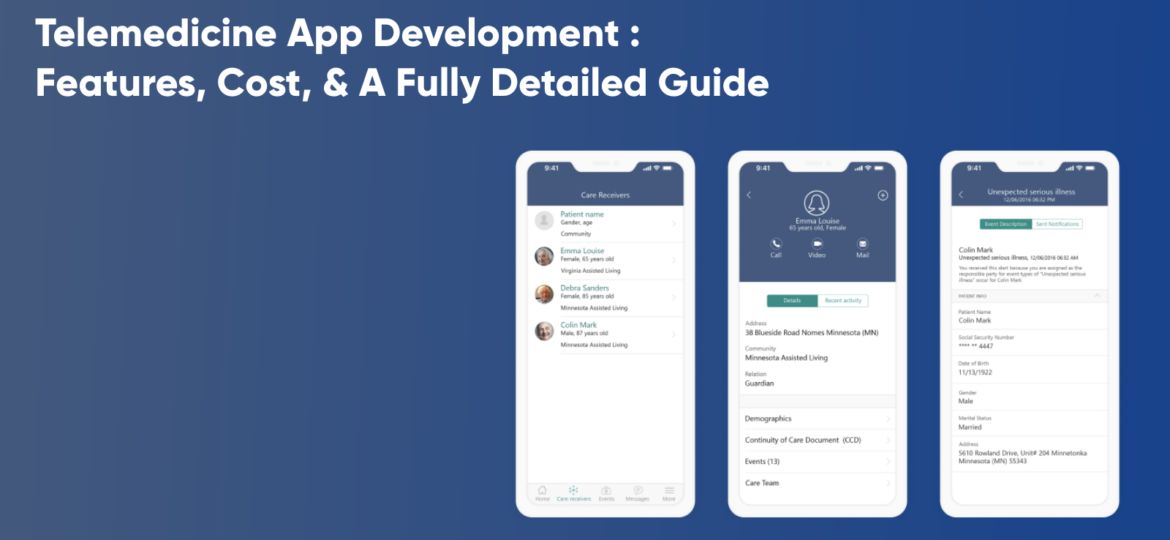If you believe that telemedicine app development is a big word for the big industry giants, then this blog is specifically for you. In addition, we have talked about almost every aspect related to the telemedicine app.
This blog is written for the people mentioned below:
- Someone who wants to build a lucrative startup
- Someone from the healthcare industry looking for new trends to beat the competition
- Tech enthusiasts
Do you know? As per Meticulous Research; the Global telemedicine market is going to develop at a CAGR of 23.0% from 2018 to the year 2023. Also, the telemedicine industry will reach more than $12,015 million by the year 2023.
Now that you are surprised by the data; let’s dig into the details of the technology and its impact on the industry.
What is the Telemedicine App?

Telemedicine refers to the practice of connecting patients and doctors remotely. This practice is getting popular with the help of HIPPA compliant healthcare apps or tools called telemedicine apps.
In short; Telemedicine apps are an advanced method of providing healthcare facilities to people around the world from a mobile device.
The patient does not have to visit the hospital for the clinic they can connect to the doctor from a mobile app via a video conferencing feature.
Why choose only HIPAA compliant telemedicine app development?

Firstly, the medical records of any patient are very important data. Secondly, consider a scenario; you have built a telemedicine app without HIPAA compliance.
As a result, your app has stored all the data of the patients and healthcare providers, now there are high chances that the mobile app development company which has developed your app might sell this data.
Hence, to protect your app from such cases you need to make sure that your app is HIPAA compliant.
Top 3 Most Popular Telemedicine Apps in 2023
Now that you are well aware of telemedicine apps it’s time to have a look at the leaders in the category. If you want to develop a telemedicine app then these are the inspirations for you:
Talkspace – #1 Rated Online Therapy, 1 Million+ User
Talkspace app helps people cope up with mental issues such as depression, anxiety, OCD, etc. Besides that, the app has a list of the leading therapist and a patient can select a therapist based on the requirement and schedule the session.
Also, the app has details about the therapist such as their bio, their study, and certifications. Besides this helps the patients to select their therapist.
Features such as video recording, chatting and photo sharing allow the patients to connect with the therapist more smoothly.
MDLIVE: Doctors On Call 24 Hours – Urgent Care Online
MDLive serves the patients on Mobile app, websites, and phone calls. It has a wide range of doctors, counselors, psychiatrists, and dermatologists.
In addition, the app is best for getting a second opinion about your treatment process or disease.
MDLive was founded in 2006 and is growing since then. Today; according to Sensortower, MDLive has more than 20k downloads around the world. It is one of the revolutions in telemedicine app development.
Doctor On Demand: Virtual Visit Doctors and Psychologists
Doctor on demand claims to treat 90 % of common health issues of the body as well as the mind. The app allows the users to register for free and charge just for the consulting fee of the doctors.
For this purpose, the doctor on-demand app is gaining eyeballs in their attractive health plans for everyone.
Lemonaid – U.S. Online Doctor | Meds delivered to your Door
This telemedicine app is a combination of health consulting and medicine delivery services. For example, the user will have to fill out a detailed form about the medical profile, including allergies and medications, and then be assigned to a doctor based on that.
Next, if the doctor prescribes a medicine then the patient can either pick up the medicine from a nearby medical store or the medicine will be delivered at the doorstep. Also; Lemonaid assists the patients with lab tests as well.
Babylon Health
Babylon provides an AI system that is designed by doctors together with scientists to analyze the condition of any patient. In brief, the app uses a deep learning method and asks questions from the patient. Moreover; it asses the symptoms and risk factors and after that a physician will be assigned.
Summing up, it is leading the race of telemedicine apps because of the effectiveness it provides by combining the latest technologies with expert professionals.
Build A Telemedicine App To Help People
Rural Population
Helps people in rural areas to get their medical care without spending money and time on travel.
Physically Disabled
In particular, you can be help people who are not in the condition to visit hospitals or clinics. Especially, people who have physical disabilities can consult a doctor and get their prescribed medicine at their doorstep with a telemedicine app.
People who have White Coat Syndrome
Generally, some people are afraid of doctors in uniform and hospitals. Therefore, these types of people can avoid visiting hospitals and talk to their health care providers through the app.
Best Practices of Telemedicine App Development
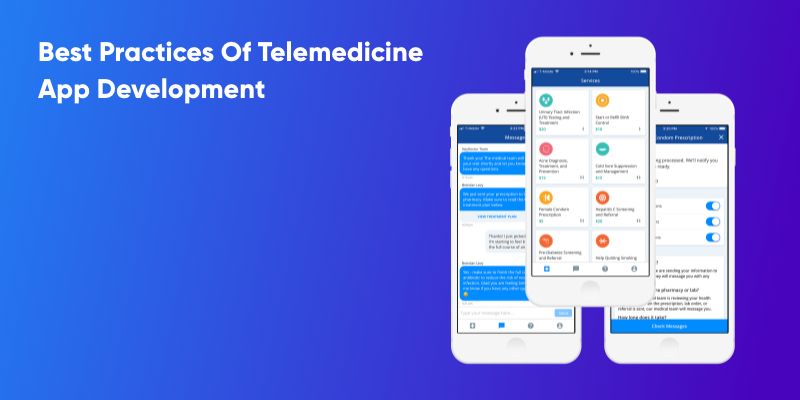
In spite of the fact that a significant number of development decisions will be required to be made through experimentation and iteration as per your telemedicine app’s unique value proposition, certain established best practices can aid take some of the guesswork out of the process and make sure that your solution meets or exceeds industry standards.
Establishing a clear product development process in advance will help keep your telemedicine app development on schedule and on budget.
Initial Planning, Scoping, & Architectural Decisions
The few most important decisions in the development process come up before a single line of code is written.
Your app will support which platform? What features are needed, and which of them need to be built from scratch?
With patients’ confidential information on the line, how will you reassure your customers that security and compliance considerations have been incorporated from the ground up?
Even on a tight deadline to deliver an MVP, a little extra time invested in getting these decisions right up front can save exponentially longer delays later on.
Platform Compatibility & Codebase Considerations
Accompanied by your app’s target market and development budget in mind, you’ll be required to decide which platforms to support and which languages to code in.
These high-level codebase considerations will determine the number of developers required and their skill sets.
The bigger platforms in play are iOS, Android, and web — and most telemedicine solutions will need to support all three.
It might be worth considering native desktop apps for Mac and Windows as well, but in most situations a browser-based web app will be better, eliminating the requirement for these desktop versions.
UI Design, Prototyping
In this era of fast-paced development workflows, it can be enticing to rush the prototyping phase and make decisions based on presumptions instead of real user feedback.
But unlike other app categories, telemedicine offers unique challenges in that it must be accessible to users.
Patients of any age may even be in a state that makes communication difficult physically, or mentally.
Basics like button design, screen layout, and menu hierarchy may be required to be modified in ways that at first feel unreasonable, so it’s crucial to take the time for appropriate UX testing cycles with focus groups and clickable mockups.
Developing for Scalability & Reliable High Performance
Scalability needs a pre-planned architectural commitment from day one, with developers teams thinking beyond the initial MVP framework and designing their code to accommodate retroactive modifications and expansions as required.
It also needs a thoughtfully arranged, highly available, and highly resilient infrastructure framework — for most of the teams, this signifies turning to one of the major cloud infrastructure-as-a-service (IaaS) providers: AWS, GCP, or Azure.
When your telemedicine app grows, a skillful developers team should handle scaling, maintenance, and troubleshooting of your pipeline and production infrastructure.
What are the benefits of telemedicine mobile app in the healthcare industry?
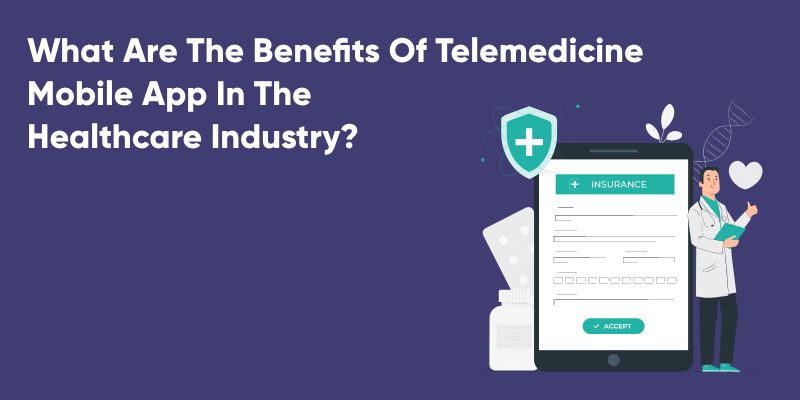
Now, next, let’s have a look at the advantages healthcare providers and patients are getting from the best telemedicine apps.
Easy and Effective Healthcare
In this busy age; no one has the time to stand in the long queues to get even the basic consultation from the doctor. Therefore with telemedicine apps, it is easy to get connected with a doctor and discuss the symptoms.
Availability at Remote Areas
Today; the internet is present everywhere but expert doctors are not present in remote places. People who are living in remote places can connect with specialists from their homes only. Thus, there will be no need to travel distances to see the doctor.
Efficient Monitoring System
Mostly, telemedicine app development will help the patients in chronic disease monitoring, follow-up consultations, and updating the prescriptions.
Record Keeping
For patients and healthcare providers; these types of healthcare apps will help in storing the data in the cloud. Hence; it will be easily accessible and safely stored.
Time Management for the Doctors
As per research by Doctor on demand; 15 percent of healthcare providers experience depression and burnout due to working 60-80 hours per week. Telemedicine solutions can be a better way to balance work and their personal life.
Why Telemedicine App Development is a Trending Business Idea?

Telemedicine is not a replacement for traditional healthcare practices, it is a support for it.
The advancement that technology is introducing in every industry sector is introducing new business opportunities such as Uber for Taxi, Uber Eats for Food, Airbnb for Accommodation. Similarly, we have telemedicine apps for healthcare.
Presently millions of Americans are using telemedicine solutions to receive medical care and this number is increasing rapidly.
With the growth in the adoption of telemedicine applications will grow with more features and advancements.
Also, the competition is not much (at least at the local level) you can start by launching a telemedicine app to connect your city/town people with the doctors in and around the city/town.
Once you are successful at the local level start expanding it to nearby cities than states and then countries.
Best Telemedicine App Development Startup Ideas
Here are the top best telemedicine startup ideas for your next business:
Patient Self-Monitoring App
Allow patients to monitor the disease at a basic level. Furthermore, patients can search for their symptoms and get the details of the doctor based on the disease implied by the doctors.
Mobile app to store and Transfer Medical Records Safely
Medical records are a very private and important document for any individual. Instead of keeping the huge files of the records patients can simply get all the data stored in the app.
Healthcare Consultation App
If you are looking for healthcare app development then you can go for a healthcare consulting app. After that, connect a doctor with a patient in the mobile app via video or audio call, chat or voice messages.
Medical Data Analytics App
Using technologies such as Artificial Intelligence and Business Intelligence, a mobile application can analyze a patient’s medical reports and diagnose the disease.
How to Develop a Telemedicine App?
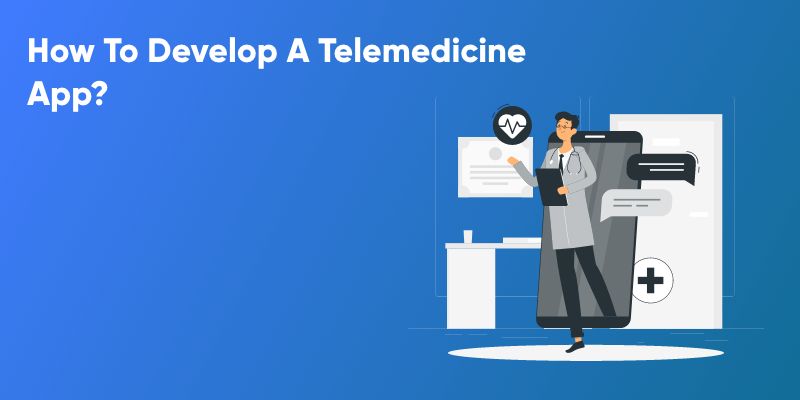
It is crucial for telemedicine app development that is easy to use and hassle-free. Hence, it can help you understand the process we have divided into simple modules. follow these steps and Add This Features to your app.
Telemedicine App Features for Doctors and Patients

Features of Doctors App in Healthcare Industry
Doctor applications are the requirement of the hour today. To make medical facilities easily accessible to all, many companies, doctors, and hospitals have tried their best to create an alternative so that patients can be assisted at home with ease.
Doctor applications are beneficial and create significant changes in the lives of people. DocsApp, a cure.fit, 1mg consultation, DocOnline are some of the good doctor’s apps.
Doctor’s Profile
A doctor must include his or her name, address, image, specialty, and availability. Also, they may provide data on their experience and education. Doctors are free to enter all the details they feel are important.
The doctor’s profile can contain information such as an address, specialization, years of experience, and education.
It would also be wise to include visiting hours of the doctor in this profile so that patients can check a doctor’s availability before booking appointments.
Scheduling/ Calendar Feature
Doctors can make changes to their schedules based on their availability. The calendar feature should be made available to the doctors, it can be then used in a wide array of applications.
The doctors can utilize the calendar feature to set their availability, manage appointments with patients who have a chronic illness, and receive consultation requests.
The Calendar feature within the telemedicine app can be used by doctors to set times for remote consultations and immediately see when an appointment is taken. A doctor appointment app is perfect in such cases.
Electronic Medical Records (EMR)
Doctors have access to the medical records of all their patients anytime they need them. The telemedicine app needs the integration of EMR to assure that workflow is flexible and that patients can easily access all the services being offered.
Each time a patient visits the clinic, his details should be updated. This makes a further diagnosis of the patient easier. EMR aids in organizing all of the patient’s information in one place, reducing paperwork for the doctor, and preventing duplication of records.
A successful EMR is based on blocks of data that can be accessed by different specialists at different levels. EMR as a feature is a bit complicated to build and has to be handled by professional developers.
Prescription Feature
The application should allow physicians to prescribe drugs right in the app. These prescriptions may be used by patients to buy medicine or to obtain other health services at medical facilities.
E-prescription eliminates a lot of paperwork and also enables the doctors to re-issue prescriptions in case of chronic illnesses. E-prescription also signifies that sales of unprescribed medication can be controlled to a large extent.
Patients don’t have to wait in long lines in order to keep up with their medication.
In spite of that, patients can simply share their credentials with the pharmacist, who can look up the details in a system and hand out medications as prescribed by the doctor online.
Communication
A robust communication feature becomes the backbone of any good telemedicine app, and doctors should be given access to various tools to get easy access to their patients.
This involves call, chat, and video conferencing. In case you are running low on budget, it is good to implement a one-to-one doctor-patient messenger with a photo-based consultation.
Enabling video conferencing is a bit more expensive, thus it is difficult to build, but something that should definitely be on your radar if you are considering expanding your app.
Features of Patients App in Healthcare Industry
Developing a patient’s app is a great idea in today’s era. Features of patients appease the activity of a patient in various ways. It promotes medical efficiency and assesses the health conditions of critical patients.
IMS Patient App, Patient Aid, Teladoc Health Patient, Patient Access are some of the good examples of Patient’s apps.
Patient Registration
This is the first step in any telemedicine app, and the goal of the registration section should be to keep it as uncomplicated as possible.
A patient should be able to log into the telemedicine portal by providing minimum details such as mobile number, email id, or via social network.
These details are personal, so it would be right to use two-factor authentication on this page, which can include voice, SMS, or phone verification.
Make sure that the registration page has a minimum number of steps to complete, to provide users easy access.
Calendar Integration
This is the important feature that you need to include in your telemedicine app is Calendar. Patients usually don’t want to have to remember when they have their next meeting with their doctor and want all the information ready at their fingertips in the telemedicine app.
Apple, Google, and Microsoft all offer their own calendar API that you can integrate into your app.
A calendar integration combined with a push notification will make sure that patients can now rely just on their smartphones to remember all future doctor’s appointments.
Patient Profile
This feature of the app will allow the patients to enter as much information as they wish to reveal, which will ultimately make diagnosis easier for the doctor.
Information required in the patient profile includes basic details such as name, age, gender, symptoms, and insurance information, among other information.
Ensure you keep the details required to a minimum and enable the patients to upload documents that will contain all the information needed by the doctors, such as insurance information or medical history.
Geolocation
Having a patient’s location helps the app find pharmacies close to the patient, give directions, and also estimate the expected time of arrival at the hospital.
Geolocation, like calendar integration, is a key feature that you need to have in your telemedicine app.
Search and Filters
A search functionality highly shortens the time required for a patient to find the information they are seeking, such as the closest eye specialist to their location.
Filters help to sort the wide amount of information available in the app, and lets the patient navigate the app faster.
Patients should be able to search for a doctor based on one or more parameters, such as specialization, ratings, proximity, etc.
Challenges in the Telehealth Industry
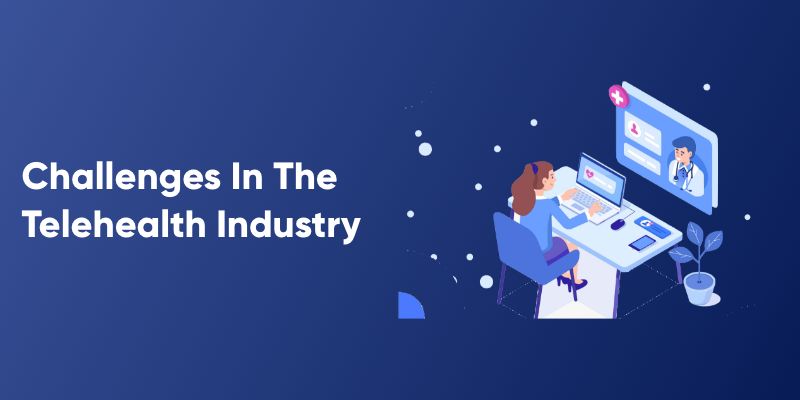
In spite of shocking stats for telemedicine apps adoptia on, there are still few challenges in telemedicine app development that developers and healthcare providers have to overcome to ensure sustainable growth of the technology.
Language Barriers
Few communities have people with poor command of English. That can negatively impact their access to quality healthcare services.
It’s because of reason that patients are unable to communicate their conditions and symptoms accurately due to the language barrier.
Due to technology development, it is possible to translate communication in real-time so both the doctor and the patient can understand each other in their own native language.
This would extremely improve each patient’s safety and safeguard against misdiagnoses, wrong prescriptions, and mismanagement.
Regulations Challenge in Telehealth
Licensing was a minor issue when ATA was formed because most telemedicine systems operated within a single state. Nowadays there are multistate practices.
As most of the major health care providers move into a national system, licensure is becoming a bigger barrier.
Practice regulations may be an even larger barrier than licensure, as many state medical boards require an in-person consultation before initiation of any telemedicine services.
Patients’ Lack of Technical Skills Challenge in Telehealth
When patients don’t understand how to use telemedicine services, it can reduce utilization and hamper accessibility.
It is a good idea to survey patients before launching your telemedicine services and ask which devices they would be most comfortable using when accessing your telemedicine services.
It’s equally important to train your staff on using your telemedicine equipment, so they can also help patients who require assistance.
Image Resolution Challenge in Telehealth
Image resolution and video quality require significant bandwidth. Providers reported the low-resolution video was less than adequate for healthcare applications.
The providers recommend introducing telehealth in pilot projects in order to work out these kinks.
Therefore, according to research, the resolution, and quality of digital video cameras have improved greatly today.
Cost to Build A Telemedicine App
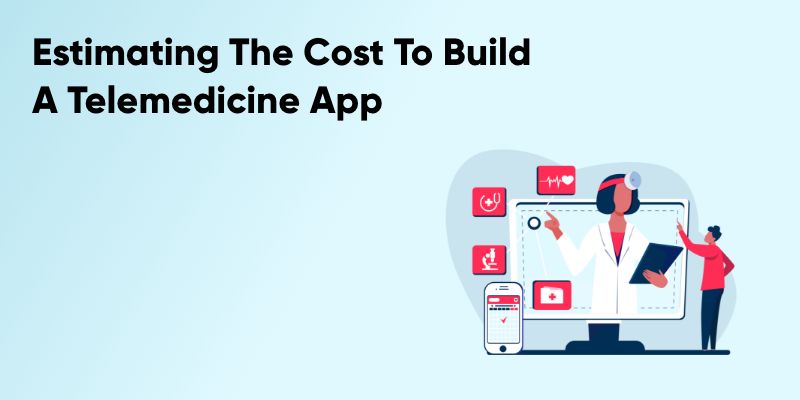
The total development cost of a telemedicine app can vary widely based on various factors. While a single developer may be able to code a simple app with fewer functions, any solution designed to meet compliance requirements and scale to compete in the market will angle toward the higher end of that spectrum, requiring some advance funding and a team of developers.
Cost may vary depending on the desired feature depth, which platforms to support, and anticipated user counts.
The number of developers and distinct developer skill sets required, their salaries and the labor hours the project will take are also responsible for the budget estimation.
The decision to build or buy component solutions will also highly influence the total development cost.
If you choose to develop a feature-rich telemedicine solution that has more functionality and complexity, your development costs can be around $150,000-$250,000. You can also use an app cost calculator to estimate the exact cost. For more info, contact us now.
Conclusion
In conclusion, now, you are very well aware of all the details of telemedicine app development; it’s time to make a decision.
Do you want to build a telemedicine app for your health care business? Or do you have a telemedicine app idea? In any case, get in touch with the experts to get a professional app to suit the requirements of your industry. Because we are here for your assistance; we will help you throughout the process.
FAQs
How do I make a telemedicine app like doctor on demand?
- Evaluate your app idea
- Ask developers for quotations
- Make the project opportunity for the
- MVP of a telemedicine platform
- Enter the development phase
- Approve the application’s demonstration
- Introduce your app in app marketplaces.
What technology does telemedicine use?
- Artificial Intelligence
- Augmented and virtual reality
- Tele-robots
- IoT and nanotechnology
- 3D Printing
Which company provides Telemedicine app development service?
Echoinnovate IT ensures to provide the best Telemedicine app development services. As a custom mobile application development company, We manage the entire lifecycle of your product planning, strategy, and app/web launch, from UI / UX design, application development or Web development, QA testing to product delivery. We have 12+ years of experience.
We have developed more than 630+ projects in various industries. Our team of mobile app developers uses the latest technology to develop the highest mobile apps.
